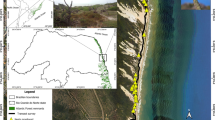Abstract
Two potential mechanisms for reducing the level of inbreeding, sex-biased dispersal and kin avoidance, were examined in the Australian sleepy lizard, Tiliqua rugosa. The home range centres, and the genotypes at four polymorphic microsatellite DNA loci were determined for adult lizards in a 70-ha study area near Mount Mary, South Australia. From estimates of genetic relatedness, females were as closely related to other females as they were to males, both within the whole study area, and within home ranges. Similarly, males were as closely related to other males as they were to females. This suggests that dispersal in the population is not sex-biased. Sleepy lizards form monogamous pairs during the spring. Partners were less closely related to each other than to other potential partners in the home range area. This suggests active choice of unrelated partners. The mechanism for recognising related from unrelated individuals is unknown, but the behaviour could reduce inbreeding.
Similar content being viewed by others
Author information
Authors and Affiliations
Additional information
Received: 7 November 1998 / Accepted: 30 May 1999
Rights and permissions
About this article
Cite this article
Bull, C., Cooper, S. Relatedness and avoidance of inbreeding in the lizard, Tiliqua rugosa . Behav Ecol Sociobiol 46, 367–372 (1999). https://doi.org/10.1007/s002650050631
Issue Date:
DOI: https://doi.org/10.1007/s002650050631




